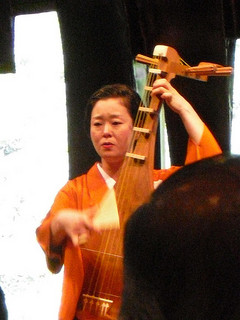Difference between revisions of "Biwa hoshi"
(Created page with "right|thumb|320px|A member of the contemporary fusion music group AURA-J performing a portion of the ''[[Tale of the Heike'' on biwa.]] *''Japanese...") |
(No difference)
|
Revision as of 14:10, 9 October 2013

- Japanese: 琵琶法師 (biwa houshi)
Biwa hôshi were blind itinerant storytellers, prominent in the mid-Heian period through the Muromachi period. Performers of epic tales, accompanying themselves on the biwa (a stringed, lute-like instrument related to the Chinese pipa), they are particularly associated with the Tale of the Heike.
The biwa hôshi tradition began in mid-Heian period, with blind men seeking refuge at Buddhist temples, where they learned to play the biwa, and to entertain with stories, and may have adopted the custom of wearing monastic robes. The biwa was associated with an ability to contact unseen or supernatural forces; because of this, combined with the monastic robes worn by these lay performers, many began to regard the biwa hôshi as, perhaps, wielding some special abilities to ward off disease, pacify angry spirits, or the like. Blind biwa-playing storytellers thus came to travel the country, providing entertainment, supernatural services, and moralizing tales, for a living.
By the 1200s, Kyoto was home to a great many biwa hôshi, as was the area in and around Enryaku-ji on Mt. Hiei. The Genpei War ended in 1185, and the political after-effects were still being felt, and so, it has been suggested, there were many stories about the conflict circulating, as well as much demand for such stories. And so, the earliest versions of the tradition of reciting The Tale of the Heike were born. There is most likely no singular original version, but in the 1330s, Yoshida Kenkô related in his Tsurezuregusa that a former Shinano province official by the name of Yukinaga composed the Tale and taught it to a blind man named Shôbutsu to tell; further, he suggested that the performance tradition of the Tale incorporated an emulation of Shôbutsu's own vocal characteristics.
References
- Helen McCullough trans., The Tale of the Heike, Stanford University Press (1990), 6-8.